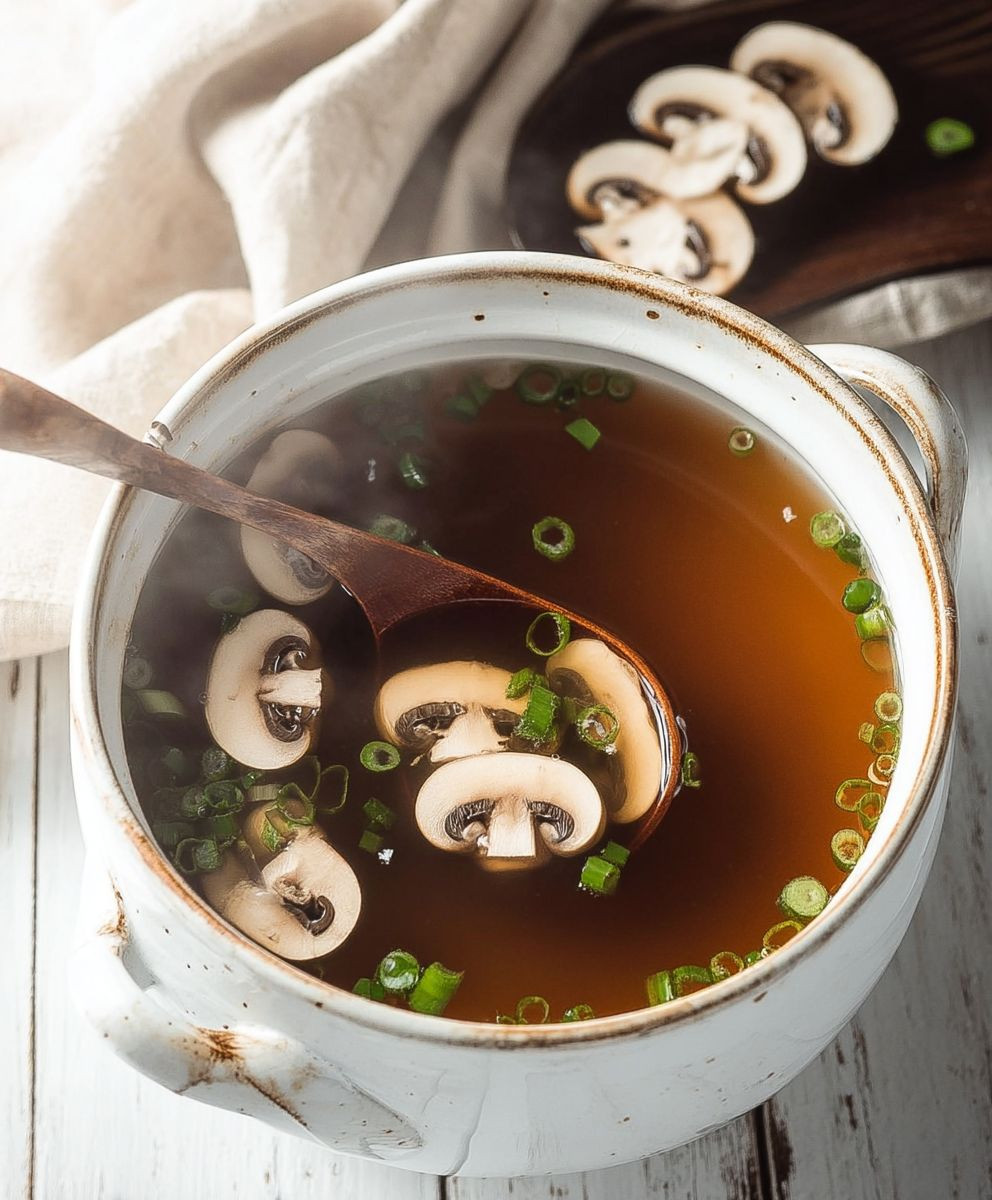Japanese Clear Soup, or suimono, is more than just a light broth; it’s a delicate dance of flavors that embodies the essence of Japanese culinary artistry. Have you ever tasted a soup so pure, so subtly seasoned, that it feels like a warm embrace from the inside out? That’s the magic of suimono.
This elegant soup has a rich history, often served in formal Japanese meals, particularly during Kaiseki, a traditional multi-course haute cuisine. It’s designed to cleanse the palate and prepare you for the dishes to come, highlighting the natural flavors of the ingredients rather than masking them with heavy sauces or spices. The clarity of the broth is not just aesthetic; it symbolizes purity and simplicity, core values in Japanese culture.
People adore Japanese Clear Soup for its light, refreshing taste and its versatility. It’s incredibly easy to customize with different proteins, vegetables, and garnishes, making it a perfect weeknight meal or an elegant starter for a dinner party. The delicate umami flavor, derived from dashi (a traditional Japanese stock), is incredibly satisfying without being heavy, and the silky smooth texture is simply divine. Whether you’re a seasoned chef or a beginner in the kitchen, this recipe is sure to impress with its simplicity and profound flavor.
Ingredients:
- 6 cups dashi (Japanese soup stock)
- 4 dried shiitake mushrooms
- 4 cups water (for soaking mushrooms)
- 2 tablespoons soy sauce
- 1 tablespoon mirin (sweet rice wine)
- 1 teaspoon salt, or to taste
- 1/4 teaspoon white pepper, or to taste
- 1/2 cup wakame seaweed, dried
- 1/4 cup mitsuba (Japanese parsley), chopped
- 1/4 cup green onions, thinly sliced
- 4 ounces silken tofu, cut into small cubes
- Optional: a few thin slices of lemon or yuzu zest for garnish
Preparing the Shiitake Mushrooms:
Before we dive into the soup itself, let’s get those shiitake mushrooms ready. Dried shiitake mushrooms add a wonderful depth of umami flavor to the soup, but they need a little bit of preparation.
- Soak the Mushrooms: Place the dried shiitake mushrooms in a bowl and pour 4 cups of water over them. Make sure the mushrooms are fully submerged. You can use a small plate or bowl to weigh them down if needed.
- Soaking Time: Let the mushrooms soak for at least 2 hours, or preferably overnight, in the refrigerator. This allows them to fully rehydrate and release their flavor into the soaking liquid.
- Remove and Slice: Once the mushrooms are rehydrated, remove them from the soaking liquid. Don’t discard the soaking liquid! It’s packed with flavor and we’ll use it later. Gently squeeze out any excess water from the mushrooms.
- Strain the Soaking Liquid: Carefully strain the soaking liquid through a fine-mesh sieve or cheesecloth to remove any sediment. Set the strained liquid aside.
- Prepare the Mushrooms: Remove the stems from the shiitake mushrooms. The stems can be a bit tough, so it’s best to discard them or save them for making vegetable stock. Slice the mushroom caps thinly.
Preparing the Wakame Seaweed:
Wakame seaweed is another key ingredient that adds a delicate sea flavor and a pleasant texture to the soup. It’s very easy to prepare.
- Rehydrate the Wakame: Place the dried wakame seaweed in a bowl and cover it with cold water.
- Soaking Time: Let the wakame soak for about 5-10 minutes, or until it has fully expanded and softened. It will increase in volume significantly.
- Drain and Chop: Drain the wakame seaweed and gently squeeze out any excess water. If the wakame pieces are very large, you can chop them into smaller, bite-sized pieces.
Making the Japanese Clear Soup:
Now that we have our ingredients prepped, we can finally start making the soup! This part is quick and easy.
- Combine the Dashi and Mushroom Liquid: In a large pot, combine the 6 cups of dashi with the strained shiitake mushroom soaking liquid.
- Bring to a Simmer: Bring the mixture to a gentle simmer over medium heat. Avoid boiling, as this can make the dashi taste bitter.
- Add the Shiitake Mushrooms: Add the sliced shiitake mushrooms to the pot.
- Season the Soup: Add the soy sauce, mirin, salt, and white pepper to the pot. Stir well to combine.
- Taste and Adjust: Taste the soup and adjust the seasoning as needed. You may want to add a little more soy sauce for saltiness, mirin for sweetness, or white pepper for a bit of spice. Remember that the wakame will also add some saltiness to the soup.
- Simmer Briefly: Let the soup simmer gently for about 5-10 minutes to allow the flavors to meld together.
- Add the Wakame: Add the rehydrated wakame seaweed to the pot. Simmer for another minute or two, just until the wakame is heated through. Be careful not to overcook the wakame, as it can become slimy.
Serving the Soup:
The final step is to serve the soup and enjoy its delicate flavors. This is where you can add the final touches to make it extra special.
- Add the Tofu: Gently stir in the silken tofu cubes into the soup. Be careful not to break the tofu.
- Ladle into Bowls: Ladle the hot soup into individual serving bowls.
- Garnish: Garnish each bowl with chopped mitsuba (Japanese parsley) and thinly sliced green onions.
- Optional Garnish: For an extra touch of elegance, you can add a few thin slices of lemon or yuzu zest to each bowl. This will add a bright, citrusy aroma and flavor.
- Serve Immediately: Serve the soup immediately while it’s hot.
Tips for the Best Japanese Clear Soup:
- Use High-Quality Dashi: The quality of the dashi is crucial for the flavor of the soup. If you’re making your own dashi, use good-quality kombu (dried kelp) and katsuobushi (dried bonito flakes). If you’re using instant dashi granules, choose a reputable brand.
- Don’t Overcook the Wakame: Wakame seaweed can become slimy if it’s overcooked. Add it to the soup just before serving and simmer it for only a minute or two.
- Adjust the Seasoning to Your Taste: The amount of soy sauce, mirin, and salt you need will depend on your personal preferences and the saltiness of your dashi. Taste the soup and adjust the seasoning accordingly.
- Use Fresh Ingredients: Fresh mitsuba and green onions will add the best flavor and aroma to the soup.
- Serve Hot: Japanese clear soup is best served hot. This will allow you to fully appreciate its delicate flavors and aromas.
Variations:
Japanese clear soup is a versatile dish that can be customized to your liking. Here are a few variations you can try:
- Add Noodles: You can add thin wheat noodles (somen or udon) to the soup to make it a more substantial meal.
- Add Seafood: You can add small pieces of cooked shrimp, crab, or fish to the soup.
- Add Vegetables: You can add other vegetables to the soup, such as spinach, mushrooms, or carrots.
- Add Egg: You can whisk an egg and drizzle it into the simmering soup to create a silky egg drop soup.
- Spicy Version: Add a pinch of red pepper flakes or a dash of chili oil to the soup for a spicy kick.
Storing Leftovers:
If you have any leftover soup, you can store it in an airtight container in the refrigerator for up to 2 days. Reheat the soup gently on the stovetop before serving. Be aware that the tofu may become a bit softer after being refrigerated.
Health Benefits:
Japanese clear soup is a light and healthy dish that is low in calories and fat. It’s a good source of vitamins, minerals, and antioxidants. The dashi provides umami flavor without adding any extra salt or fat. The wakame seaweed is a good source of iodine, which is essential for thyroid health. The tofu is a good source of protein and calcium.
Enjoy!
I hope you enjoy this recipe for Japanese clear soup. It’s a simple yet elegant dish that is perfect for a light lunch, a starter course, or a comforting meal on a cold day. With its delicate flavors and beautiful presentation, it’s sure to impress your family and friends.
Conclusion:
So there you have it! This Japanese Clear Soup recipe is more than just a simple broth; it’s a comforting, flavorful experience that’s incredibly easy to create in your own kitchen. I truly believe this is a must-try recipe for anyone looking to expand their culinary horizons or simply seeking a light and nourishing meal. The delicate balance of umami, saltiness, and subtle sweetness makes it incredibly satisfying, and the versatility of the ingredients allows you to customize it to your liking.
Why is this Japanese Clear Soup a must-try? Well, beyond its incredible taste, it’s also incredibly adaptable. It’s perfect as a light lunch, a soothing starter to a larger meal, or even a comforting late-night snack. Plus, it’s a fantastic way to use up leftover vegetables and proteins, minimizing food waste and maximizing flavor. The simplicity of the preparation also makes it a winner – even if you’re a beginner cook, you can easily master this recipe and impress your friends and family.
Serving Suggestions and Variations:
The possibilities are truly endless when it comes to serving and varying this Japanese Clear Soup. Here are a few ideas to get you started:
- Tofu and Seaweed: Add cubes of silken tofu and a handful of wakame seaweed for a classic and satisfying combination.
- Mushrooms: Sliced shiitake, enoki, or oyster mushrooms add an earthy depth of flavor. Sauté them lightly before adding them to the broth for an extra layer of richness.
- Noodles: Transform this soup into a heartier meal by adding thin udon or somen noodles. Cook the noodles separately and add them to the soup just before serving to prevent them from becoming soggy.
- Chicken or Shrimp: For a protein boost, add shredded cooked chicken or small cooked shrimp.
- Ginger and Garlic: A small amount of grated ginger and minced garlic can add a warming and aromatic touch. Be careful not to overdo it, as they can easily overpower the delicate flavors of the soup.
- Spicy Kick: If you like a little heat, add a pinch of red pepper flakes or a few drops of chili oil.
- Garnish: A sprinkle of chopped scallions, toasted sesame seeds, or a drizzle of sesame oil adds visual appeal and enhances the flavor.
Don’t be afraid to experiment and find your own favorite combinations! The beauty of this recipe is that it’s a blank canvas for your culinary creativity. Think about what flavors you enjoy and what ingredients you have on hand, and let your imagination run wild.
I’m so excited for you to try this Japanese Clear Soup recipe! I truly believe you’ll love its simplicity, its versatility, and its incredible flavor. It’s a dish that I find myself making again and again, especially when I’m craving something light, healthy, and comforting.
Once you’ve given it a try, I would absolutely love to hear about your experience. Did you make any variations? What were your favorite additions? Did you serve it as a starter, a main course, or a snack? Share your thoughts, photos, and tips in the comments below! Your feedback is invaluable, and it helps me to continue creating recipes that you’ll love. So go ahead, get in the kitchen, and whip up a batch of this delicious and comforting Japanese Clear Soup. Happy cooking!
Japanese Clear Soup: A Delicious & Healthy Recipe
A delicate and flavorful Japanese clear soup (Suimono) featuring dashi broth, shiitake mushrooms, wakame seaweed, and silken tofu. A light and comforting soup perfect as a starter or light meal.
Ingredients
Instructions
Recipe Notes
- Use high-quality dashi for the best flavor.
- Don’t overcook the wakame seaweed.
- Adjust the seasoning to your taste.
- Fresh ingredients will add the best flavor and aroma.
- Serve hot.






Leave a Comment